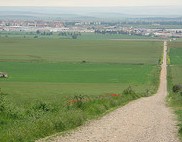
Camino Santiago
‘The Way of Saint James,’ or in Spanish, ‘El Camino de Santiago,’ is one of the most important pilgrimages in the Catholic world. The actual pilgrimage itself stretches across northern Spain, from the French border, all the way to the Cathedral of Santiago de Compostela, on the Spanish western coast, near the mighty Atlantic Ocean. This ancient pilgrimage, which has be trekked by the faithful for more than a millennia, got its start when the apostle of Christ, Saint James, ended up in Santiago.
The legend says that James was sent to Iberia to preach, and convert people to Christianity. After a while, around 44 AD, he made his way back to Jerusalem. Unfortunately for Saint James, Herod Agrippa decided to cut his head off, and thus made him a Christian martyr. People believe that his disciples took his body, placed it on a boat made of stone (somewhere near present day Israel) and set it adrift. Angels led the boat out of the Mediterranean, and up the Atlantic coast to northern Spain. A queen buried the body, and it was forgotten for hundreds of years. Another version of the story says that the body of Saint James was sent on a boat to Spain, but lost at sea, yet somehow the Saint’s body washed ashore, covered in scallops. Eventually, the body was buried in Santiago.
Regardless of what story you choose to believe, if any, ‘The Way of Saint James’ has historically been one of the most important pilgrimages in the Christian religion, along with the pilgrimages to Jerusalem and Rome. The actual route can be walked, biked and even taken on horseback. The most devote of pilgrims usually walk it, which can take anywhere from 6 to 9 weeks, depending on the speed of the walker, weather conditions, and so on. The are refuges (refugios) and rural house for weary pilgrims along the way, which can be quite mountainous, as well as inns and plenty of little towns where people can stop for a meal or stock up on provisions. Many who do walk the trail carry scallop shells, in honor of Saint James, as well as the ‘Credencial,’ which is a kind of ‘pilgrim’s passport’ that allows people to stay in refuges for free or reduced prices. It’s also something to remember the journey by, as the passport will be stamped at every refuge along the way.
The final destination is the Cathedral in Santiago, of course, and the Pilgrim’s Mass held every day at noon. No matter if your religious or not, the Camino Santiago is a splendid way to see a lot of Spain, and slowly soak in copious amounts of culture and history.
 Follow
Follow


